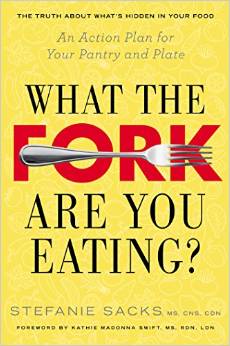
Living in Manhattan, I’m constantly bombarded by signs of the so-called “health” craze that’s sweeping the city. Every other restaurant claims to be organic, and my grocery store aisles are loaded with low-fat/sugar-free/hormone-free products. It seems like everyone’s more concerned with what isn’t in their food than with what actually is.

Here’s where my friend Stefanie Sacks comes in. Stefanie is a chef and registered nutritionist who just wrote a fascinating new book called What the Fork Are You Eating? An Action Plan for Your Pantry and Plate (Tarcher). The book explores and debunks the mysteries of food labeling, and offers solutions on how to shop for and prepare truly nutritious and wholesome meals for yourself and your family.
As a professional, a mother, and a consumer, Stefanie offers truly insightful and helpful advice on how to stop believing the labels and start educating yourself so you can select healthier alternatives. My family and I have benefitted immensely from Stefanie’s expertise, and I want to share it with you and your family as well. Here’s one of my favorite parts of the new book, on everything you need to know about food labels and ingredients:
What the Fork to Do
- The longer the ingredient list, the more processed the food; the shorter the list, the less processed. (I generally stick to packaged products with no more than five to seven ingredients.)
- All ingredient lists are written in descending order, meaning that the first ingredient listed is present in the greatest quantity in the product. So try to avoid products with sugar as one of the top three to five ingredients.
- Scrutinize sugar, as it is often present in great quantity in packaged foods and is not just listed as such but also as its many other names and iterations, as noted in Chapter 5, “Sugar and Its Many Euphemisms.”
- Never trust the word “natural” on a label, as there are no stringent regulations on the real meaning of the word.
- When you see tons of vitamins and minerals on an ingredient list, note that they are added into your foods during processing because the processing of the food strips many of these critical nutrients away.
- If you can’t pronounce it, you probably shouldn’t consume it.
- If you have any food allergies, call the manufacturer directly to inquire about those insignificant ingredients.
- If you want to know specifics about foods and their ingredients, including nutritional, health, and environmental implications, check out the Environmental Working Group’s Food Database — the authority for consumer-friendly food transparency at your fingertips. Visit their website at www.ewg.org for the Food Database or download the smartphone app of the same name.
Excerpted from What the Fork Are You Eating? An Action Plan for Your Pantry and Plate by Stefanie Sacks. © 2014 by Stefanie Sacks. Published by Jeremy P. Tarcher/Penguin, Penguin Group USA, A Penguin Random House Company.

